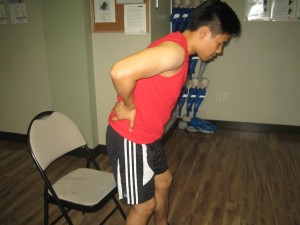A bruised tailbone develops once the area is damaged and caused by falling backward or through vaginal birth. The tailbone or coccyx is a region of the spine that is comprised of the last 3-5 vertebrae at the base of the spinal column. A doctor should be consulted if the individual has any of the indications of a bruised tailbone due to the possibility for a fracture of other underlying health conditions that requires further care.
Bruising
Bruising is the main symptom linked with a bruised tailbone. A bruise manifests once the tissues below the skin surface are broken and the upper skin layer stays intact.
In most cases, the skin close to the base of the spine appears discolored and can initially turn dark reddish or purple in color. Once the bruised tailbone starts to recuperate, the skin close to the injury site can momentarily change in appearance to green, blue or yellow up until it fully heals.

Pain
Once the tailbone is damaged, one of the initial symptoms is pain in the lower region of the back. The pain caused by an injury to the tailbone can be persistent which makes it hard to stand or sit normally.
The sore symptoms are usually localized to the injury site but can radiate across the lower back or up the spinal column. There is also difficulty walking after the injury which can disrupt with the ability to perform normal daily activities.
Swelling
Injuries to the tissues due to a bruised tailbone can lead to mild to moderate swelling at the base of the spine. The skin at the site of injury appears enlarged or puffy. Always bear in mind that the swelling due to a bruised tailbone contributes to difficulties with movement and usually occurs along with other symptoms such as tenderness, bruising or discomfort.
Constipation
A damaged tailbone can also lead to inflammation within the lower back that can radiate to the intestinal tract. Once this occurs, the individual ends up with constipation as one of the symptoms. Always bear in mind that this is a condition characterized by normal stool production that becomes difficult, painful or impossible. Other symptoms linked with constipation include bloating, abdominal pain or cramping.

